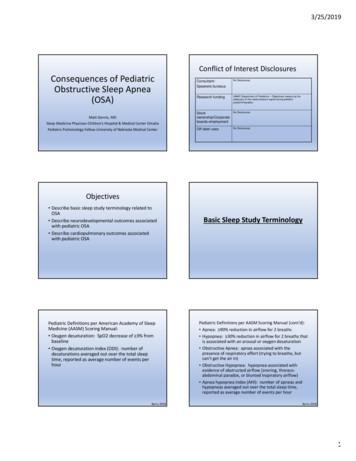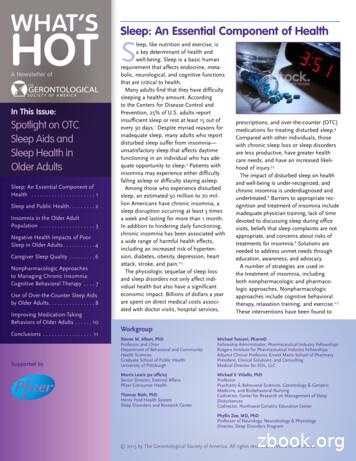Sleep Medicine - AASM
Sleep MedicineCertification Examination BlueprintPurpose of the examThe exam is designed to evaluate the knowledge, diagnostic reasoning, and clinical judgment skillsexpected of the certified sleep medicine specialist in the broad domain of the discipline. The ability tomake appropriate diagnostic and management decisions that have important consequences for patientswill be assessed. The exam may require recognition of common as well as rare clinical problems forwhich patients may consult a certified sleep medicine specialist. The exam is developed jointly by theABIM, the American Board of Anesthesiology, the American Board of Family Medicine, the AmericanBoard of Otolaryngology, the American Board of Pediatrics, and the American Board of Psychiatry andNeurology.Exam contentExam content is determined by a pre-established blueprint, or table of specifications, which is reviewedannually and updated as needed for currency. Trainees, training program directors, and certifiedpractitioners in the discipline are surveyed periodically to provide feedback and inform the blueprintingprocess.The primary medical content categories of the blueprint are shown below, with the percentage assignedto each for a typical exam:Medical Content CategoryNormal Sleep and VariantsSleep-Wake TimingInsomniaHypersomnolenceParasomniasMovement DisordersBreathing DisordersSleep in Other DisordersTotal% of Exam20%10%17%12%6%8%22%5%100%The blueprint can be expanded for additional detail as shown below. Each primary medical contentcategory is listed again, with the percentage of the exam devoted to this content area. Below eachmajor category are the content subsections and their percentages within the exam. Please note: Thepercentages for each subsection describe content of a typical exam and are approximate; actual examcontent may vary.
Normal Sleep and Variants20% of ExamSleep-wake mechanisms, neurophysiologyNeurophysiologyOther topics in sleep physiologyChronobiology/NeurophysiologyCircadian timingHomeostatic sleep regulationOther topics in chronobiology/neurophysiologySleep at different ages/stages of human lifeInfancyChildhoodAdolescenceAdulthoodElder yearsPregnancyMenopauseOther topics in sleep at different ages/stagesEffects of sleep deprivationNeurocognitive functionMood disturbancesMetabolic disturbancesOther effects of sleep ory eventsMovementCardiacEEG variantArtifactOther staging/scoring topicsSleep-Wake Timing10% of ExamCircadian sleep disordersDelayed sleep phase typeAdvanced sleep phase typeNonentrained type (free-running circadian sleep disorder)Irregular sleep-wake typeOther types of circadian sleep disordersShift workJet lagOther timing disruptions related to behavior, medical conditions, ordrugs or other substancesApproximate% of Exam4%2%2%2%2.5%7.5%Approximate% of Exam6% 2% 2%2%
Insomnia17% of ExamGeneral topics on insomniaAdjustment sleep disorderPsychophysiologic insomniaParadoxical insomniaInsomnia due to mental disorderIdiopathic insomniaInadequate sleep hygieneBehavioral Insomnia of childhoodSleep onset associationLimit settingOther insomnias related to behavior, medical conditions, or drugsor other substancesApproximate% of Exam2% 2%2% 2%2% 2%2%3.5% 2%Hypersomnolence12% of ExamApproximate% of ExamNarcolepsyType IType IIPsychiatric disordersPeriodic hypersomnia (Kleine-Levin syndrome)Idiopathic hypersomniaInsufficient sleep syndromePost-traumatic hypersomniaOther hypersomnias related to behavior, medical conditions, ordrugs or other substances5%Parasomnias6% of ExamSleepwalkingSleep terrorsREM sleep behavior disorderNightmare disorderConfusional arousalsEnuresisSleep-related eating disorderSleep-related hallucinationsSleep paralysisOther types of parasomnias 2% 2% 2%2.5% 2% 2%Approximate% of Exam 2% 2% 2% 2% 2% 2% 2% 2% 2% 2%
Movement Disorders8% of ExamRestless legs syndromePeriodic limb movement during sleepRhythmic movement disorderBruxismOther types of movement disordersBreathing Disorders22% of ExamObstructive sleep apneaCentral sleep apneaCheyne-Stokes respirationPeriodic breathing at high altitudeIdiopathic central apneaPrimary sleep apnea of childhoodMixed apneaRelated to medicationOther topics in central sleep apneaSleep-related hypoventilation/hypoxemic syndromesCongenital hypoventilation syndromesAcquired hypoventilation syndromesOther types of sleep-related breathing disordersSleep in Other Disorders5% of ExamNeurologicNeurodegenerative and neuromuscular disordersCerebrovascular disordersSeizure disordersCongenital disordersHeadachesNeurodevelopmentalOther neurologic topicsPsychiatricMood disordersPsychotic disordersAnxietySubstance abuseOther psychiatric topicsOther medical disordersGenetic conditionsApproximate% of Exam3.5%2% 2% 2% 2%Approximate% of Exam9.5%8%3% 2%Approximate% of Exam2%2% 2%
Endocrine disordersCardiac disordersPulmonary disordersGastrointestinal disordersOther medical disorders that affect sleepExam questions in the content areas above may also address clinical topics in pediatric medicine,pharmacology, sleep evaluation, and organ system physiology that are important to the practice of sleepmedicine specialists.Exam formatThe exam is composed of multiple-choice questions with a single best answer, predominantly describingpatient scenarios. Questions ask about the work done (that is, tasks performed) by physicians in thecourse of practice:Making a diagnosisOrdering and interpreting results of testsRecommending treatment or other patient careAssessing risk, determining prognosis, and applying principles from epidemiologic studiesUnderstanding the underlying pathophysiology of disease and basic science knowledgeapplicable to patient careClinical information presented may include other media illustrating relevant findings, such as diagnosticimaging studies.Exam tutorialA tutorial including examples of ABIM exam question format can be found athttp://www.abim.org/exam/prepare.aspx.Published January 2015
ABIM, the American Board of Anesthesiology, the American Board of Family Medicine, the American Board of Otolaryngology, the American Board of Pediatrics, and the American Board of Psychiatry and Neurology. Exam content Exam content is determined by a pre-established blueprint, or ta
established by the AASM (The AASM Manual for the Scoring of Sleep and Associated Events published by the AASM in 2012). The user will have the choice of identifying hypopneas according to the Recommended or Alternate criteria of the 2012 AASM guidelines. Recommended criteria is defined as a reduction in airflow of at least 30% accompanied by
update of the 2007 AASM Manual for the Scoring of Sleep and Associated Events. J Clin Sleep Med. 2012;8(5):597‐619. Berry RB, Brooks R, Gamaldo CE, Harding SM, Lloyd RM, Quan SF; for the American Academy of Sleep Medicine. The AASM Manual for the Scoring of Sleep and
the most well-run sleep labs he has ever reviewed. AASM is the gold standard by which the medical community and the public evaluate sleep medicine . facilities. Achieving the five-year AASM accreditation . demonstrates a sleep medicine provider's commitment to high-quality, patient-centered care through adherence to these standards.
SCORING SLEEP STAGES This session based on adult scoring rules - AASM Version 2.2 (2015) SCORING SLEEP STAGES Based on unit of epoch - 30s in most labs Each epoch reviewed in turn and assessed as a whole for its sleep stage In some situations, the page before or after can influence the decision
Academy of Sleep Medicine [AASM] Scoring Manual, 2020). Apnea Hypopnea Index (AHI): The number of Apneas plus the number of Hypopneas during the entire sleeping period, times 60, divided by total sleep timein minutes; unit: event per hour (AASM Scoring Manual, 2020).
Nov 12, 2018 · 2 The Sleep in America poll was run alongside the National Sleep Foundation’s validated sleep health assessment tool, the Sleep Health Index , which has been fielded quarterly since 2016.The Index is based on measures of sleep duration, sleep quality and disordered sleep. Am
of the Scoring Manual Committee that the online manual will continue to advance the field of sleep medicine and improve the quality of care for patients with sleep disorders. 2012–2013 AASM Scoring MAnuAl coMMittee: Richard B. Berry, MD, Chair Rita Brooks, MEd, RST, RPSGT Charlene E. Gamaldo, MD Susan M. Harding, MD Carole L. Marcus, MBBCh
uals experience disturbed sleep at least a few nights each week12 . Research presented at SLEEP 2013, the 27th Annual Meeting of the Associated Professional Sleep Societies, LLC, addressed sleep-related topics ranging from basic sleep science, such as cell and molecular genetics, to such clinical topics as sleep disorders and sleep and aging .























